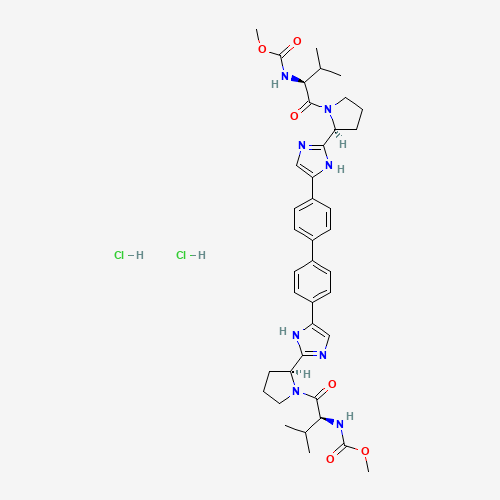| Pharmaceutical Information |
| Drug Name |
Daclatasvir dihydrochloride |
| Drug ID |
BADD_D00569 |
| Description |
Daclatasvir is a direct-acting antiviral agent against Hepatitis C Virus (HCV) used for the treatment of chronic HCV genotype 1 and 3 infection. It is marketed under the name DAKLINZA and is contained in daily oral tablets as the hydrochloride salt form . Hepatitis C is an infectious liver disease caused by infection with Hepatitis C Virus (HCV). HCV is a single-stranded RNA virus that is categorized into nine distinct genotypes, with genotype 1 being the most common in the United States, and affecting 72% of all chronic HCV patients [L852]. Daclatasvir was the first drug with demonstrated safety and therapeutic efficacy in treating HCV genotype 3 without the need for co-administration of interferon or [DB00811]. It exerts its antiviral action by preventing RNA replication and virion assembly via binding to NS5A, a nonstructural phosphoprotein encoded by HCV. Binding to the N-terminus of the D1 domain of NS5A prevents its interaction with host cell proteins and membranes required for virion replication complex assembly. Daclatasvir is shown to target both the cis- and trans-acting functions of NS5A and disrupts the function of new HCV replication complexes by modulating the NS5A phosphorylation status [A19640]. The most common critical NS5A amino acid substitutions that led to reduced susceptibility to daclatasvir therapy occured at position Q30 (Q30H/K/R) and M28 in genotype 1a patients and Y93H in genotype 3 patients.
According to 2017 American Association for the Study of Liver Diseases (AASLD), 60mg of daclatasvir is recommended with 400mg [DB08934] for genotype 1a/b patients with or without cirrhosis as second-line therapy. The same dosing regimen can be used as first-line therapy in patients with genotype 3 without cirrhosis and second-line therapy in genotype 3 patients with compensated cirrhosis. Combination therapies that include daclatasir can be used for challenging-to-treat patients who have HIV-1 coinfection, advanced cirrhosis, or post-liver transplant recurrence of HCV [L863]. The therapy is intended to cure or achieve a sustained virologic response (SVR12), after 12 weeks of daily therapy. SVR and eradication of HCV infection is associated with significant long-term health benefits including reduced liver-related damage, improved quality of life, reduced incidence of Hepatocellular Carcinoma, and reduced all-cause mortality [A19626].
Daclatasvir was FDA-approved in July 2015 for use with [DB08934] (Sovaldi) with or without [DB00811] to treat HCV genotype 1 and 3 infections. The SVR12 in HCV genotype 1a-infected treatment-naïve subjects without and with cirrhosis undergoing daclatasvir and [DB08934] therapy were 88% and 99%, respectively [FDA Label]. The same dosing regimen in treatment-naïve patients with HCV genotype 3 infection with or without cirrhosis achieved SVR12 rates of 71% and 98%, respectively [FDA Label]. |
| Indications and Usage |
Indicated for use with sofosbuvir, with or without ribavirin, for the treatment of chronic HCV genotype 1a/b or 3 infection. The dosing regimen of 60mg daclatasvir 60 mg with 400mg sofosbuvir once a day is recommended for both genontypes.
Resistance: Reduced susceptibility to daclatasvir was associated with the polymorphisms at NS5A amino acid positions M28, Q30, L31, and Y93 in genotypes 1a, 1b, and 3a patients. NS5A Resistance Testing is recommended for HCV genotype 1a-infected patients with cirrhosis prior to the initiaition of the treatment, as the risk of resistance development is higher in genotype 1a patients. |
| Marketing Status |
approved; investigational |
| ATC Code |
J05AP07 |
| DrugBank ID |
DB09102
|
| KEGG ID |
D10105
|
| MeSH ID |
C549273
|
| PubChem ID |
25154713
|
| TTD Drug ID |
D09SGV
|
| NDC Product Code |
68554-0094; 17381-130; 69766-063; 66039-941 |
| UNII |
50ZO25C11D
|
| Synonyms |
daclatasvir | carbamic acid, N,N'-((1,1'-biphenyl)-4,4'-diylbis(1H-imidazole-5,2-diyl-(2S)-2,1-pyrrolidinediyl((1S)-1-(1-methylethyl)-2-oxo-2,1-ethanediyl)))bis-, C,C'-dimethyl ester | daclatasvir dihydrochloride | Daklinza | BMS-790052 | BMS-790052-05 |
|
| Chemical Information |
| Molecular Formula |
C40H52Cl2N8O6 |
| CAS Registry Number |
1009119-65-6 |
| SMILES |
CC(C)C(C(=O)N1CCCC1C2=NC=C(N2)C3=CC=C(C=C3)C4=CC=C(C=C4)C5=CN=C(N5)C6CCCN6C(=O)C
(C(C)C)NC(=O)OC)NC(=O)OC.Cl.Cl |
| Chemical Structure |

|
|
| ADRs Induced by Drug |
|
|
*The priority for ADR severity classification is based on FAERS assessment, followed by the most severe level in CTCAE rating. If neither is available, it will be displayed as 'Not available'.
**The 'Not Available' level is hidden by default and can be restored by clicking on the legend twice..
|
|
|

